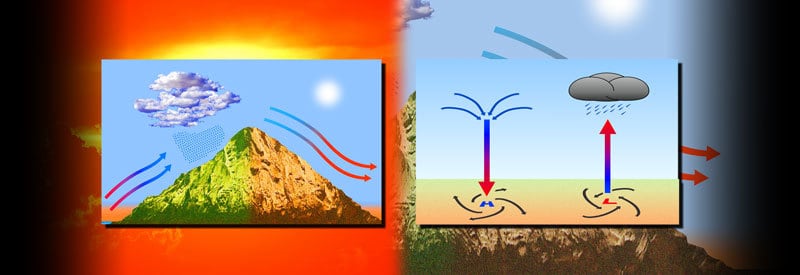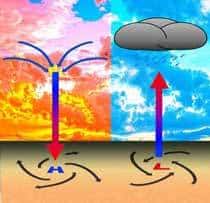Defining The Adiabatic Process – What It Is And How It Occurs

The various processes at work in our atmospheric air are crucial to weather formation and impact most meteorological events. The adiabatic process defines air pressure's role in an isolated body of air.
In meteorology, the adiabatic process primarily describes the process of heating or cooling a body of air without any energy being exchanged with the surrounding air mass. Temperature changes occur due to an air pocket's compression or expansion due to pressure changes in the air surrounding it.
Think of the internal combustion engine (ICE) used in traditional motor vehicles. Without the air pressure created in the combustion chamber to drive the piston inside a cylinder, the ICE will not be able to operate.
Similarly, the steam engine, which was widely used during the early stage of the Industrial Revolution, operates on the same principle. Heat is applied to a confined chamber, causing moist air inside to expand, which in turn forces the cylinders to move up and down.
The three factors that play an essential role in both these processes are heat, air pressure, and a confined body of air. And it is these three factors that also create a similar process in meteorology. It is called the adiabatic process.
As already shown, the adiabatic process is used in a variety of different disciplines. However, this post will focus exclusively on the adiabatic process as it applies to meteorology.
Adiabatic Process Definition
During the introduction, you already received plenty of clues as to what the adiabatic process entail and was probably able to form a vague idea of its definition.
It is essential, however, to get a clear and concise definition of what precisely the adiabatic process is before examining how this phenomenon takes place.
What Is The Adiabatic Process?

In meteorology, the adiabatic process primarily describes the heating or cooling of a body of air without any energy exchanged with the surrounding atmosphere. The temperature changes occur due to the air pocket's compression or expansion as a result of pressure changes in the surrounding air.
One of the most vital characteristics of the adiabatic process to highlight is the fact that the process takes place in relative isolation. It simply means that no mixing of air takes place between the body of air and the surrounding atmosphere.
There is a second important characteristic of the adiabatic process in meteorology. This is because it occurs as a result of the surrounding atmosphere's pressure on the air pocket, specifically in adiabatic cooling and heating.
Now that it has been established that the heating and cooling of a body of air is one of the primary impacts of the adiabatic process, the focus should now be on how these cooling and heating processes take place.
Adiabatic Cooling
Adiabatic cooling is a natural occurrence that takes place in the lower atmosphere and is primarily due to a change in altitude. Usually, the altitude change occurs through one of two processes. These two processes are:
- The Heating Of A Layer Of Air At The Surface
- Forced Elevation Due To A Rise In Geographical Terrain
1) The Heating Of A Layer Of Air At The Surface

When solar radiation heats the Earth's surface, it also warms the air above it. The warm body of air is less dense (and lighter) than the surrounding air and starts to rise. As it gains altitude, it continues to move into areas with less density, causing it to expand even further.
Any body of air contains a large number of molecules that vibrate and bounce off each other. The closer these molecules are to each other, the quicker they vibrate and collide with each other. We observe this as a rise in temperature.
In this case, however, the body of air expands as it gains altitude, where the atmosphere has less air pressure. It means the molecules move further away from each other, becoming less energetic with fewer collisions occurring, resulting in a drop in temperature.
2) Forced Elevation Due To A Rise In Geographical Terrain
Sometimes, adiabatic cooling is not the result of the heating of a surface. When prevailing winds (like a sea breeze blowing inland) are present, a layer of air is moved horizontally but sometimes encounters a raised terrain like a mountain or large hillside.
As a result, the layer of air is forced to rise against the mountain slopes. As the altitude increases, the atmospheric pressure becomes less, allowing the air pocket to expand and cool down in the same way a body of warm air rising from the surface would.
This form of adiabatic cooling is also known as orographic cooling, which forms part of the Orographic Effect. To find out more about this phenomenon and how it occurs, you can read the in-depth article here.
The rate at which temperature drops as altitude increases is called the adiabatic lapse rate. The amount of moisture in the air plays a role in the rate at which temperature decreases and can be divided into the:
Dry Adiabatic Lapse Rate: When there is little or no moisture present in the air parcel, it will cool at an average rate of 10° Celsius per 1 000 meters (5.6° Fahrenheit / 1 000 Feet).
Wet (Moist) Adiabatic Lapse Rate: When a substantial amount of moisture is present in a body of air that is rising, it will cool at an average rate of 5° Celsius per 1 000 meters (3.2° Fahrenheit / 1 000 Feet).
Please note that these figures are just average lapse rates and will vary according to more specific atmospheric conditions.
Adiabatic Heating
The adiabatic process takes place in reverse during an occurrence of adiabatic heating.
When a body of air at higher altitudes starts sinking to the ground, it gets subjected to increased atmospheric pressure as it moves closer to the planet's surface. The increased pressure causes the air parcel to compress and shrink in size.

As already discussed, when a body of air contracts, the molecules inside get energized as it starts to vibrate more quickly and collide with each other at an accelerated pace. This process manifests as a rise in temperature.
One example of adiabatic heating occurs during a heat burst when a layer of cold, dry air drops to the ground from a high altitude in the wake of a dissipating thundercloud.
Another example is part of the Orographic Effect, as cold, dry air drops down the slopes on the leeward side of a mountain.
Conclusion
The adiabatic process plays a vital role in many fields and disciplines. It also has a significant role to play in several meteorological occurrences.
In this post, we focused on adiabatic heating and cooling and illustrated how they could impact the weather without any energy exchange with external elements like solar radiation, wind, and moisture.
The main goal of this article was to explain the adiabatic process, how it occurs and highlighted some examples of this phenomenon.
Never miss out again when another interesting and helpful article is released and stay updated, while also receiving helpful tips & information by simply clicking on this link .
Until next time, keep your eye on the weather!
